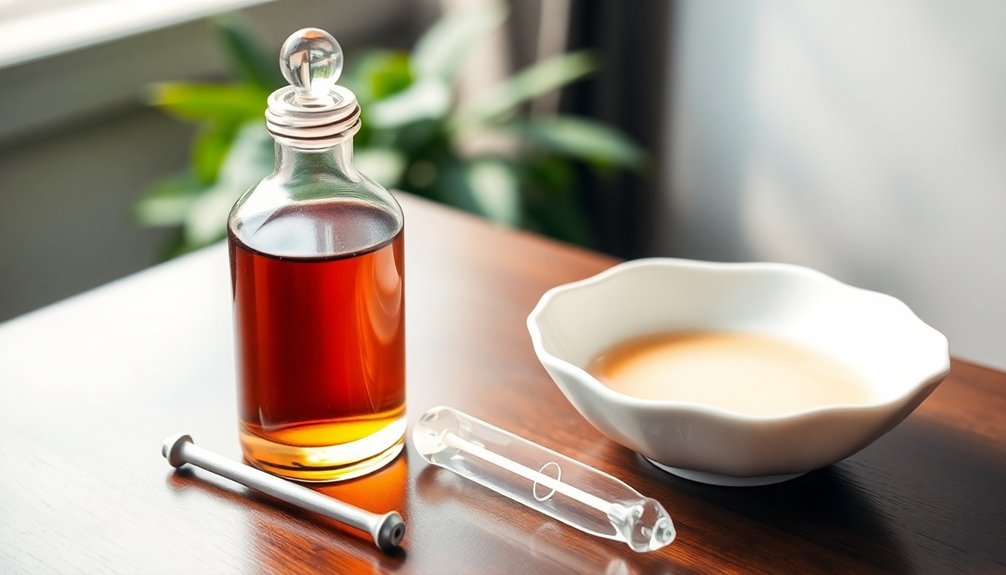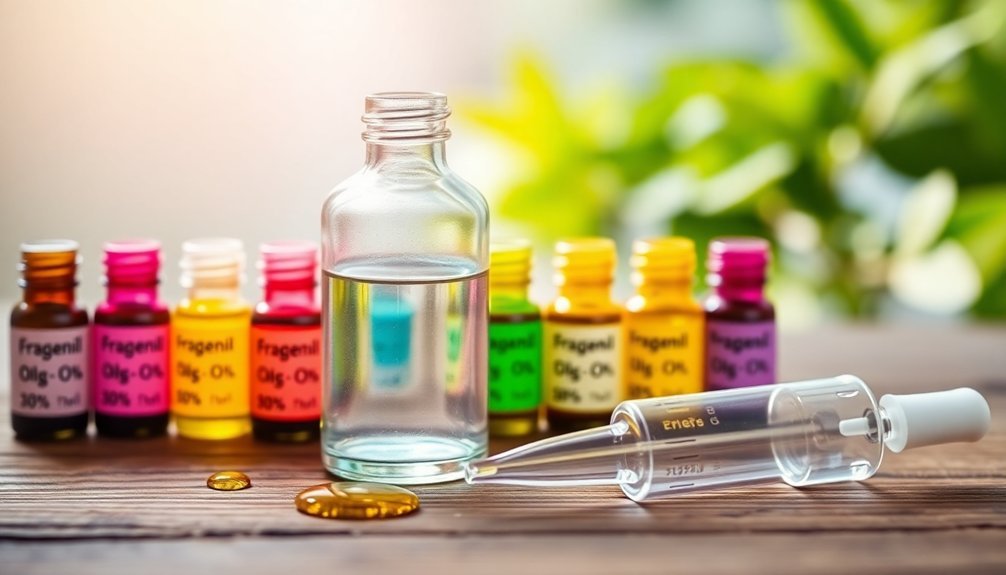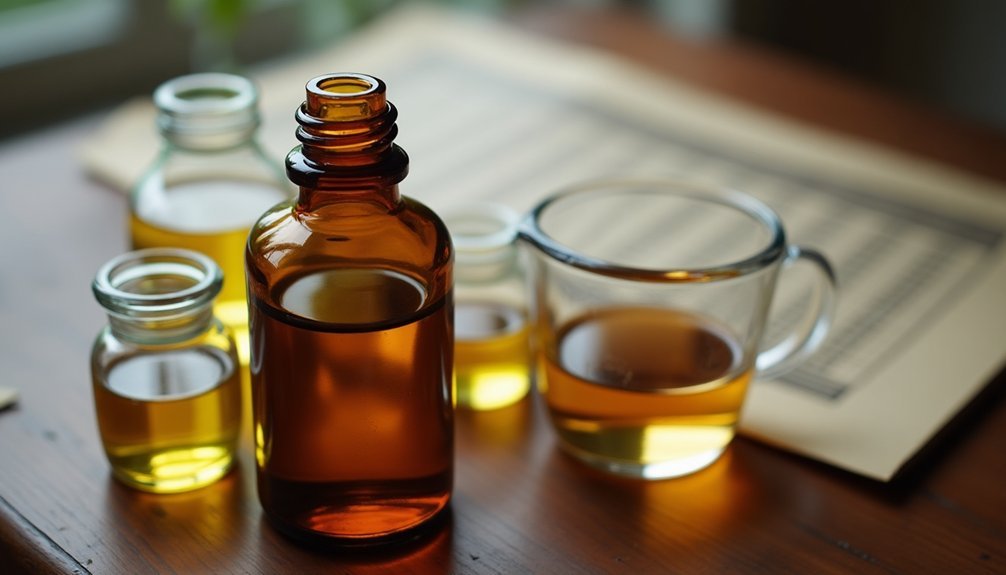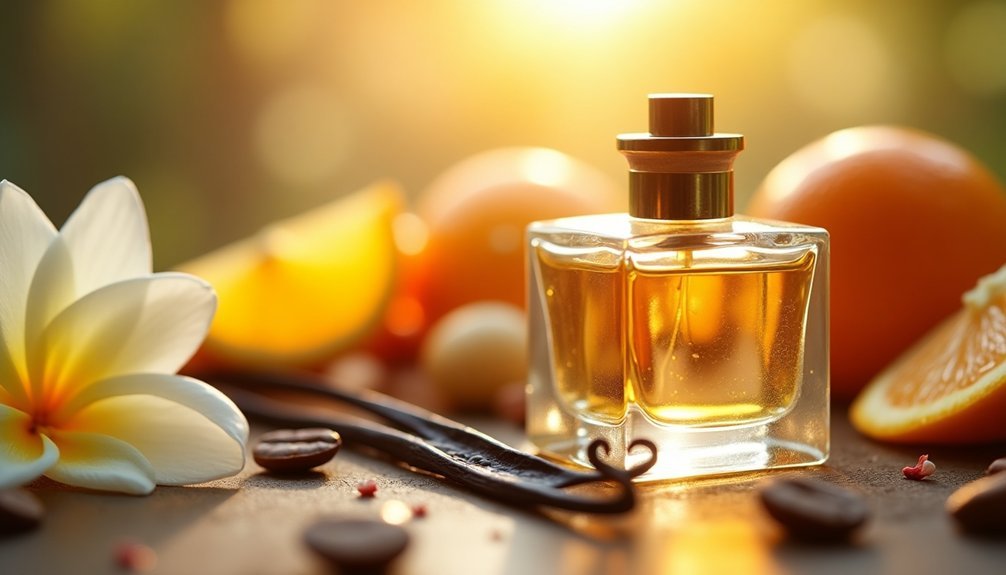The right fragrance oil dilution ratio varies based on your product type. You'll want to use 1-3% for personal care products, 0.5-1% for room sprays, and 15-20% for eau de parfum. For skin-safe applications, stick to 1-3 ml of fragrance oil per 100 ml of carrier oil. Remember to adjust these ratios based on oil potency to avoid irritation. Understanding proper concentration levels will help you create professional-quality fragrances.
Understanding Basic Fragrance Oil Dilution Ratios

Three key ratios form the foundation of fragrance oil dilution: personal care products at 1-3%, room sprays at 0.5-1%, and eau de parfum at 15-20%.
When you're working with personal care items, you'll want to blend 1-3 ml of fragrance oil per 100 ml of carrier oil, like jojoba or sweet almond oil.
For room sprays and diffusers, use a lighter touch with 0.5-1 ml of fragrance oil per 100 ml of water or alcohol.
If you're creating an eau de parfum, mix 15-20% fragrance oil with 80-85% alcohol for a long-lasting scent.
Remember that these ratios aren't set in stone – you'll need to adjust based on the potency of your oils. It's crucial to follow these guidelines as undiluted oils can cause severe skin irritation and chemical burns.
Synthetic fragrances can handle higher dilutions, while essential oils require lower concentrations.
Essential Measurements for Safe Perfume Making
When making perfumes, you'll need to measure your fragrance oils carefully, keeping total concentrations between 20-30% for ideal scent strength and safety.
You can achieve professional results by using a precision scale that measures to 0.01g, which lets you maintain IFRA-compliant ratios of base, heart, and top notes in your formulations.
For safe dilution, mix your measured oils with appropriate carrier bases like perfumer's alcohol or MCT oil, ensuring thorough blending for 1-2 minutes. Using glass containers and beakers helps maintain purity and prevents contamination during the mixing process.
Understand Base Note Proportions
Because precise measurements are essential for safe perfume making, you'll need a reliable scale that measures down to 0.01g for accurate base note proportions.
Don't rely on drops, as essential oils have varying weight-to-volume ratios that can affect your final composition.
Base notes should make up 5-10% of your perfume blend, creating a foundation that guarantees your scent lingers.
When working with essential oils, keep dilutions at or below 10% for safety. If you're using synthetic fragrance oils, you can explore higher concentrations up to 25%.
Common base notes like Sandalwood, Vanilla, and Patchouli provide depth to your fragrance.
Start with small amounts and adjust gradually to achieve the perfect balance with your top and middle notes.
A traditional eau de parfum formula uses 70% alcohol base for optimal fragrance diffusion.
Remember to follow IFRA safety guidelines for specific oils.
Perfume Concentration Guidelines
Understanding perfume concentration guidelines is essential for creating safe and effective fragrances.
You'll find four main concentration types: Parfum (20%-50%), Eau de Parfum (15%-20%), Eau de Toilette (5%-15%), and Eau de Cologne (2%-4%). Each type offers different longevity and cost implications.
When formulating, always use percentages rather than drops for precise measurements. For example, a 20% concentration in 100g would require 20g of fragrance oil and 80g of base.
You'll need to take into account the product type too – body washes typically need around 1% fragrance, while facial products use 0.3%-0.8%.
Remember to check IFRA guidelines for safety compliance, and allow at least 30 days for maturation when mixing oils with perfumer's alcohol.
Safe Mixing Techniques
Safe perfume mixing demands precise measurements and careful attention to concentration limits.
You'll need a scale that can measure tiny amounts (down to 0.005 grams) and precision droppers for accurate fragrance oil measurements. Never exceed 10% essential oil concentration for skin applications, even though synthetic fragrance oils might allow higher ratios.
When you're creating blends, start small with test batches of 0.1 oz or a few drops. This lets you perfect your formula before scaling up.
Always follow IFRA guidelines and consult SDS documentation for each oil you're using. Keep detailed records of your successful ratios and dilutions for future reference.
For consistency, measure by weight rather than volume, as fragrance oil densities can vary greatly.
Carrier Oil Selection and Blending Proportions
Selecting the right carrier oil forms the foundation of successful fragrance blending. For sensitive skin, you'll want to use hypoallergenic options like sweet almond or jojoba oil.
If you have oily skin, opt for lightweight carriers such as grapeseed or fractionated coconut oil.
When it comes to blending proportions, start with 15-30 drops of fragrance oil per ounce of carrier oil. You can adjust this ratio based on your scent preference and the strength of your fragrance.
For long-lasting scents, choose jojoba or apricot kernel oil as your base. If you're working with delicate fragrances, sweet almond oil's subtle profile won't interfere with your blend.
Remember to let your mixture mature for at least two weeks in a cool, dark place to develop its full fragrance profile.
Calculating Perfect Fragrance Concentrations

Once you've chosen your carrier oils, precise calculations become the key to achieving your desired fragrance strength.
You'll need to determine your target concentration based on the type of product you're creating – whether it's a perfume at 20%, eau de parfum at 15%, or eau de toilette at 10%.
To calculate your fragrance oil amount, multiply your total volume by the desired concentration percentage.
For example, if you're making 100ml of perfume at 20% concentration, you'll need 20ml of fragrance oil and 80ml of carrier oils or alcohol.
For more precise measurements, convert volumes to weights using ingredient densities.
If you're working with potent materials, consider using serial dilutions to achieve accurate concentrations, especially when dealing with ingredients that require minimal percentages like 0.1%.
Common Dilution Mistakes to Avoid
When you're working with fragrance oils, it's critical to avoid over-diluting your essential blends, which can weaken their therapeutic properties and intended effects.
Combining incompatible carrier oils can destabilize your formulation and reduce its shelf life, so always verify oil compatibility before mixing.
Temperature fluctuations during the dilution process can greatly alter your blend's properties, making it essential to follow specific temperature guidelines for each oil type.
Over-Diluting Essential Blends
Despite the common belief that "more dilution means safer use," over-diluting essential oil blends can greatly reduce their therapeutic benefits.
When you dilute beyond recommended ratios, you'll compromise the potency and effectiveness of your blend, potentially wasting valuable oils without achieving desired results.
To maintain peak benefits, stick to standard dilution guidelines:
- 1% for sensitive skin (1 drop per teaspoon of carrier oil)
- 2% for general use (2 drops per teaspoon)
- 3% for acute conditions (3 drops per teaspoon).
While safety is vital, excessive dilution won't provide adequate skin protection or therapeutic effects.
Remember that each oil has its ideal concentration range – what works for lavender mightn't work for tea tree oil.
Mixing Incompatible Carrier Oils
Proper dilution ratios are just one part of successful fragrance formulation – selecting compatible carrier oils is equally important.
When substituting carrier oils, you'll need to match the viscosity and absorption rates of your original formula to maintain product stability and effectiveness.
Don't overlook the importance of odor compatibility. Choose carrier oils with mild aromas that won't compete with your fragrance oil.
You'll want to avoid pungent oils like Neem or Broccoli Seed Oil in delicately scented products.
Color considerations are also vital – steer clear of vibrant oils like Carrot Seed or Sea Buckthorn Berry if you're aiming for a neutral-colored product.
Remember to take practical aspects into account too. Select carrier oils that fit your budget and are readily available to guarantee consistent production without supply chain interruptions.
Ignoring Temperature Guidelines
Temperature guidelines serve as a vital safety measure in fragrance oil dilution, particularly for candle making. When you're working with fragrance oils, you'll need to maintain temperatures between 185 and 200 degrees Fahrenheit to guarantee proper blending and safety.
If you ignore these temperature guidelines, you're risking uneven distribution of fragrance oil in your wax, which can create dangerous pockets of pure fragrance that might ignite during burning.
Don't let flash point concerns distract you – they're irrelevant to the temperature at which you should add fragrance oil. While temperature won't affect your candle's hot throw, it's essential for safety and consistency.
Measuring Tools and Equipment Guidelines
Accurate measurements are essential for achieving consistent fragrance oil dilutions.
You'll need specific tools to guarantee precision: a digital scale for weight measurements, graduated cylinders for medium quantities, and pipettes or dropper bottles for small amounts.
Set up your equipment properly by calibrating your scale to measure in grams or ounces, and use the tare function to exclude container weight.
Keep your workspace clean and dry, and maintain separate measuring tools for different fragrances to prevent cross-contamination.
Always measure by weight rather than volume since fragrance oils have varying densities.
Calculate your fragrance load based on your wax type's compatibility, and start with smaller quantities when testing new scents.
Remember to record your measurements to maintain consistency in future batches.
Skin-Safe Dilution Percentages

When working with fragrance oils for skin applications, following safe dilution percentages is essential to prevent adverse reactions and skin sensitivity.
For adult use, you'll want to stick to a 2% dilution ratio, which means 12 drops of essential oil per ounce of carrier oil.
You'll need to adjust these ratios based on specific needs. If you have sensitive skin, use a 0.25-1% dilution with no more than 6 drops per ounce. For children and elderly individuals, don't exceed 1% dilution.
Some oils require special attention – clove bud oil shouldn't exceed 0.5%, while holy basil can go up to 1%.
For different product types, you'll use varying concentrations: facial products work best at 0.3-0.8%, while wash-off products can handle up to 1-2% dilution.
Storage and Preservation of Diluted Fragrances
Proper storage of diluted fragrances plays an essential role in maintaining their quality and extending their shelf life.
You'll want to keep your diluted fragrances at room temperature between 65°F to 85°F, away from heat sources and temperature fluctuations.
Store your fragrances in dark, opaque containers or boxes to protect them from light damage.
Don't place them near windows or under artificial lighting, as this can break down the fragrance molecules.
Keep them in a space with moderate humidity (50-60%), avoiding bathrooms and other damp areas.
To prevent oxidation, always keep your bottles tightly sealed when not in use.
Don't shake them unnecessarily, as this creates air bubbles that can affect the fragrance quality.
Using airtight containers for storage will help preserve your diluted fragrances longer.
Professional Perfume Dilution Standards

Beyond storage considerations, understanding professional dilution standards allows you to create consistent, high-quality fragrances.
Professional perfumers typically dilute materials to 10-20% before blending, using weight-to-weight measurements rather than volume-based ratios.
You'll need to match your dilution to your product type. For Eau de Parfum, aim for 15-35% concentration in mass market products or 20-40% for artisanal creations.
Eau de Toilette works best at 2-15%, while body splashes need only 0.5-1.5%. For precise measurements, you'll want to use a reliable weighing machine and stick to consistent units like grams.
Remember that essential oils require lower dilutions (1-3%) than synthetic fragrance oils (10-20%) due to their higher potency.
Testing and Adjusting Your Fragrance Blends
Testing fragrance blends requires a systematic approach to confirm consistent, reliable results.
You'll want to start by using smelling strips to evaluate individual oils, then create small test batches using wax melts or diffusers to assess scent throw and longevity.
Begin with a 1:1 ratio when blending fragrances, and adjust based on each oil's strength.
Keep your testing conditions uniform by using the same materials and concentrations across all samples.
Document everything in a fragrance journal, including the blend ratios, test dates, and observations.
Get feedback from trusted testers and evaluate your blends in different settings.
Don't rush the process – allow your blends time to mature and fuse.
Compare your results with similar market products to confirm you're meeting quality standards.
Frequently Asked Questions
Can Fragrance Oils Be Diluted With Water Instead of Carrier Oils?
No, you can't directly dilute fragrance oils with water as they won't mix properly. You'll need to use carrier oils, alcohol, or witch hazel as intermediaries to achieve proper dilution and dispersion.
How Long Do Properly Diluted Fragrance Oils Maintain Their Scent Strength?
You'll find properly diluted fragrance oils typically maintain their scent strength for 6-12 months. However, your storage conditions and the oil's quality will greatly influence how long they'll stay potent and true to scent.
Does Altitude Affect Fragrance Oil Dilution Ratios When Making Candles?
No, altitude won't affect your fragrance oil dilution ratios in candle making. While it may impact how your candle burns, you'll still use the same recommended 6-10% fragrance load for your wax.
Can I Mix Different Fragrance Oils Before Diluting Them?
Yes, you can mix different fragrance oils before diluting them. Just make sure you're working in a well-ventilated area and keep track of your proportions to maintain consistency when diluting the final blend.
Do Synthetic and Natural Fragrance Oils Require Different Dilution Temperatures?
Yes, you'll need different temperatures for synthetic and natural oils. While synthetics can handle higher heat, you should add natural oils at lower temperatures (155-165°F) to preserve their properties and scent profiles.
In Summary
You'll find success in fragrance creation by following proper dilution ratios, typically ranging from 10-30% for perfumes and 2-15% for body products. Remember to test your blends, store them properly, and always prioritize skin safety. With practice and careful measurement, you'll develop a keen sense for creating perfectly balanced fragrances that are both beautiful and safe to wear.





Leave a Reply